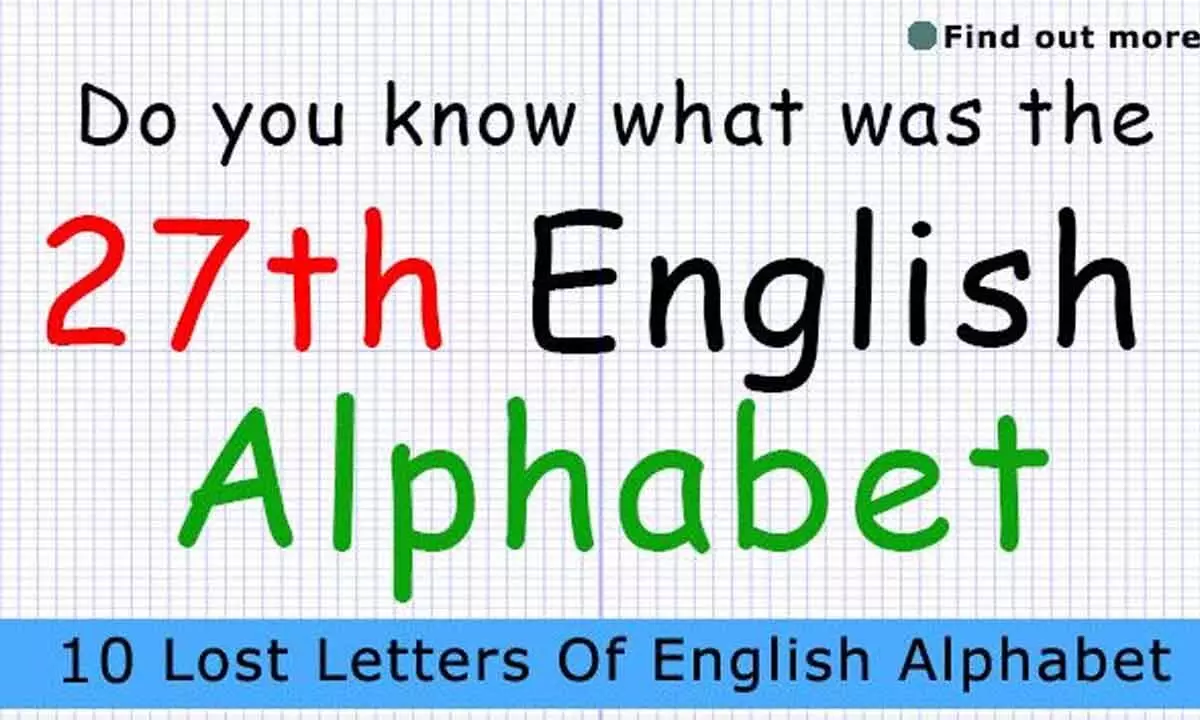Live
- They always want me to win, and now I feel lucky to have been offered a story like ‘Zebra’: Satyadev Kancharana
- ‘Democracy first, humanity first’: PM Modi in Guyana's parliament on two countries' similarities
- PKL Season 11: Telugu Titans register third straight win to top standings
- Is Pollution Contributing to Your COPD?
- NASA Unveils Underwater Robots for Exploring Jupiter's Moons
- Additional Central forces arrive in violence-hit Manipur
- AR Rahman and Saira Banu’s Divorce: Legal Insights into Common Issues in Bollywood Marriages
- 82.7 pc work completed in HPCL Rajasthan Refinery area: official
- Curfew relaxation extended in 5 Manipur districts on Friday
- Tab scam prompts Bengal govt to adopt caution over fund disbursement
Just In
Is there a 27th letter in the English alphabet?


Bengaluru design school students endeavouring to create it to address pronunciation disparities between English and French
Bengaluru: In a bold and innovative move, design students at LISAA, Bengaluru, have challenged the conventional wisdom surrounding the English alphabet by introducing a 27th letter. This ground-breaking initiative aims to address the pronunciation disparities between English and French, offering a unique solution that transcends linguistic boundaries.
The endeavour unfolded during a dynamic typography and product design workshop at LISAA School of Design in the city, bringing together 2nd-year degree students from LISAA Bangalore DESIGN and visiting students from LISAA France.
The process of creating the new letter involved meticulous sketching of various prototypes until the optimal version was selected. Subsequently, the chosen design underwent digital refinement using industry-standard software like InDesign or Illustrator, adhering to the fundamental principles of typography and leveraging baseline grids for precision.
Avi Keswani, Founder and Director of LISAA School of Design, emphasised the workshop’s broader objective, stating, “Language operates as a social agreement where we collectively assign specific meanings to arbitrary words within that language. For instance, the greeting ‘hello’ holds no scientific significance; its meaning is derived purely from our cultural understanding.
‘Similarly, the concept of alphabets delves into semiotics, where letters function as symbols. These symbols gain meaning within a cultural context, such that ‘A’ represents ‘A’ only when interpreted within that context. As designers, we aim to foster a mindset that questions norms and encourages thought-provoking ideas.’
‘This exercise served as a psychological exploration - can we challenge the notion of why English is confined to 26 alphabets? Our objective with this exercise was to provide students with a contextual framework. Being a French school of design, we recognised the challenges English speakers face in mastering certain French pronunciations. Hence, the creation of the 27th alphabet aimed to act as a bridge between these two languages, serving as the premise for our creative endeavour.”
The workshop commenced with an in-depth exploration of linguistic nuances and phonetic principles, augmented by a special presentation on phonetics by Madhuri Welling, a French language expert. Students embarked on a creative journey, sketching multiple iterations of the 27th letter and experimenting with diverse shapes and forms to achieve visual harmony and typographic integrity.
Beyond digital creation, students delved into traditional artistic techniques such as wood carving and printmaking to imbue the letter with tangible authenticity and craftsmanship. This hands-on approach underscores the workshop’s interdisciplinary nature, blending modern digital design with traditional artistry to create a multifaceted representation of the new letter.
The significance of this endeavour transcends its technical aspects, serving as a homage to the evolution of language and a celebration of ingenuity and exploration.
The introduction of the 27th letter symbolises the intersection of tradition and innovation, offering a visually captivating solution to linguistic challenges.
Moreover, this project evokes parallels with historical precedents, such as Ian Fleming’s involvement in a typographical competition in 1947.
Fleming’s curiosity-driven initiative mirrors the spirit of experimentation and curiosity that defines this workshop, highlighting the enduring relevance of exploring new avenues in design and language.

© 2024 Hyderabad Media House Limited/The Hans India. All rights reserved. Powered by hocalwire.com






